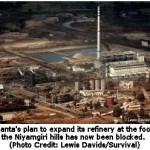Guru Arjan Dev Institute of Development Studies, Amritsar (India), organized a two-day national seminar on October 23-24, 2010, jointly sponsored by Department of Biotechnology, CSIR, NABARD and Ministry of Earth Science, Government of India. A total of 65 papers were presented during the seminar in four different sessions. A book entitled “Management of Natural Resources and Environment in India” brought out by the institute was also released during the seminar.
Dr. Gursharan Singh Kainth, the Director of the institute, introduced the theme of the seminar, “Management of Natural Resources & Environment in India”, and endorsed the need for strengthening the three mutually reinforcing pillars of sustainable development, i.e., economic development, social development and environmental protection at local, national, regional and global levels.

Following recommendation emerged from the two-day deliberations:
Strategizing for achieving water resource sustainability is a very complex undertaking. The fast-growing demand for water from different sectors of the economy and society, the low water use efficiency, the rapidly falling ground water tables, the increasing pollution of surface and ground-water bodies, uncertainty in resource availability exacerbated by increased variability in weather and changing climatic patterns, the access to water and rising social conflicts in sharing of water resources, unclear and undefined water rights, lack of appropriate institutions and policies, etc., have brought water sustainability to the core debate of sustainable development. While the concern over sustainable development, management and use of water resources is being increasingly emphasized; however, the means to achieving this goal are still hazy or unclear.
Various conceptual frameworks of water governance reforms and the experiences in water governance over the last two decades in the country so far are more in the nature of a piece-meal and ad-hoc approach akin to coping strategies rather than aiming at identifying long-term solutions to water governance issues. The focus should be diverted from capture and augmentation of water related services to the redistribution of water and creating institutional arrangement. In the face of growing water scarcity and for promoting more efficient use of available water technological interventions in the nature of micro-rrigation technologies (drip and sprinkler) are being emphasized. The key suggestions being reduction in capital cost of the system, provision of technical support for MI operation after installation, relaxation of farm size limitation in providing MI subsidies and single state-level agency for implementation of the MI program.
In the face of declining ground-water tables and increasing demand for surface water from different sectors of the society, there is need for formation of a national water resource management policy acceptable to different stakeholders as a means for promoting sustainable use of water resources by different sectors of the society. Such a policy, besides administrative measures, must give due consideration to the role of prices in ensuring a more equitable and sustainable use of water resources. Groundwater is under serious threat in several parts of India. Falling groundwater tables pose serious threat to sustainability of water resources. In the face of declining groundwater tables, recharge of groundwater is increasingly being advocated. Several methods of groundwater recharge are available – roof-top rainwater harvesting, recharge wells, percolation tanks, injection wells, etc.
Sustainability of water resources requires consideration of not only quantity aspects but also quality issues. There is a risk of fluoride contamination which could lead to health problems like discoloration of teeth and bone damage. A constant vigil by monitoring groundwater situation so that serious degradation of water resources could be avoided and water use could be sustained for future generations.
The impact of watershed management programme in wastelands can make for food security and conservation of natural resources in a participatory mode. In the initial phase of implementation, the project provided substantial economic benefits to the participating members. It was basically the donor agency’s involvement which brought people in the watershed together. Once the full implementation phase was over, owners of advantageous lands tried to extract more benefits without bothering others. The Village Watershed Committee became non-operational and could not succeed in keeping people from all categories united for the cause of watershed and its long term benefits. As a result, the benefits which emanated from watershed development in the initial years vanished.













